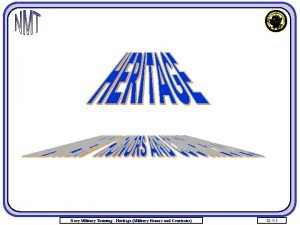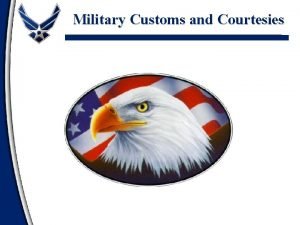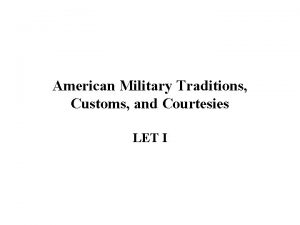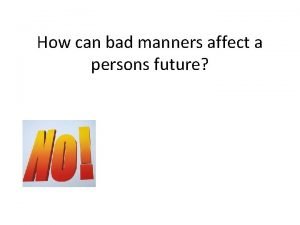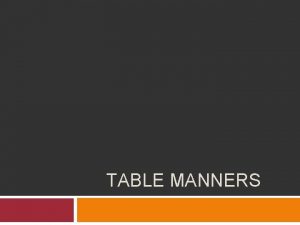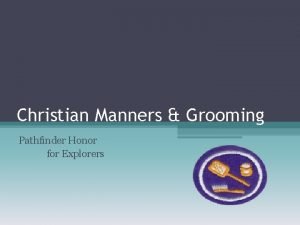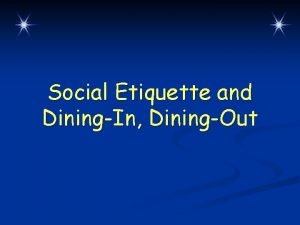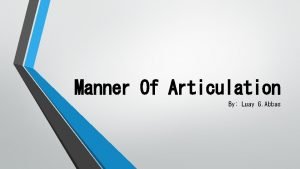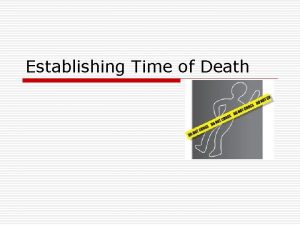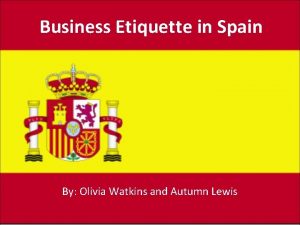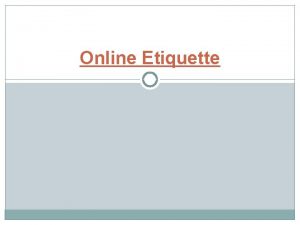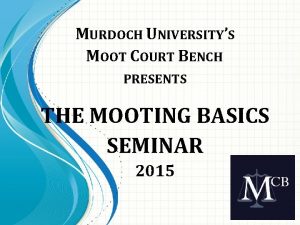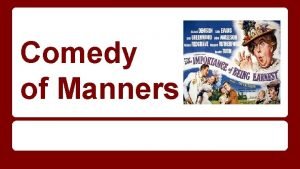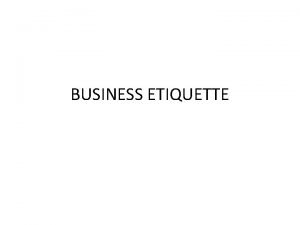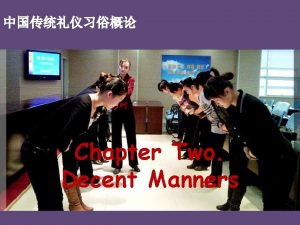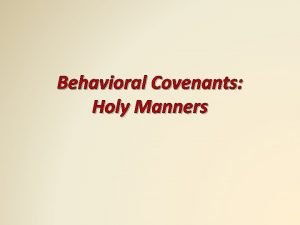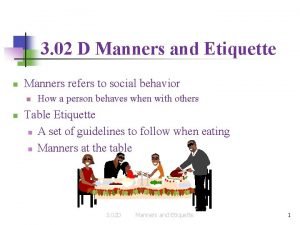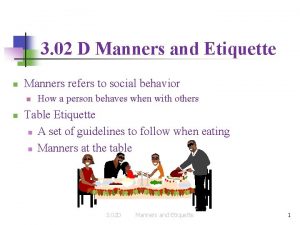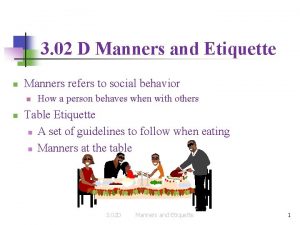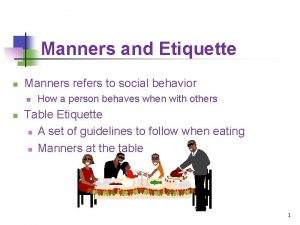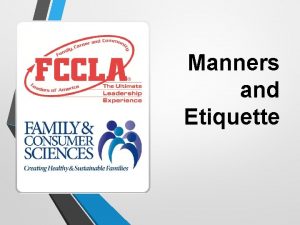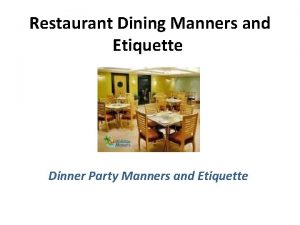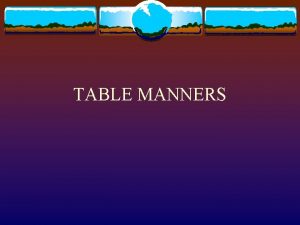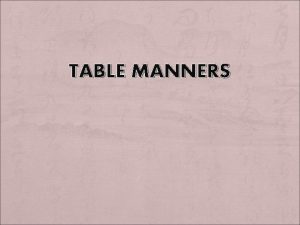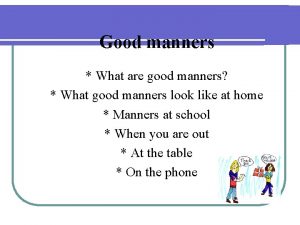Unit 2 MANNERS AND COURTESIES Leadin 1 Pair
































- Slides: 32

Unit 2 MANNERS AND COURTESIES(礼貌,�恭 ) 社交礼仪与礼节

Lead-in 1. Pair work: work with your partners and list some bad manners which annoy you most in public places. 2. Please rank “Top Ten” from the following uncivilized conducts in campus life. And compare them with your partners. 1) Spit and litter at will. 2) Speak impolitely and scornfully. 3) Finish dining without putting a cutlery back. 4) Trample lawn, and pick flowers. 5) Paste up posters where they shouldn’t come into view. 6) Leave the blackboard unclean before another class. 7) Play truant, absent without asking for a leave. 8) Smoke in the teaching area. 9) Cheat in an examination, and copy homework.

10) Scratch on the desks, walls, etc. 11) Damage public properties. 12) Waste food, water and electricity. 13) Take seats long before arriving. 14) Stay in the classroom without switching off mobile phone or turning it into silent mode. 15) Talk loudly in the library or classroom. 16) Read and spread unhealthy books and watch nasty video products 17) Show excessive intimacy in public places. 18) Behave rudely in public places (such as picking nose, blowing one's nose, digging one's ears, sneezing at others) 19) Dress not properly in public places (such as dressing in slippers , a pajama and etc. ) 20) Cut in lines or jump the queue (e. g lunch time, shopping in supermarket)

3. Look at the following picture. Do you think they behave well or not? If not, try to specify them.

“Your manners shows thoughtfulness and consideration for others. ” —Lois Hearn, Etiquette Consultant

On the road Observe the public transport etiquettes strictly and conscientiously On the pavement: l l Don’t litter. Don’t split. Don’t block the way. Don’t dwell on talking for long time on the roadside. Driving vehicles: l l Observe the traffic regulations; Slow down speed; Don’t blow horns at will; shift the lights at night

1. The Way of Expressing Courtesy Working places and library: keep quiet In the park: keep good manners and be aware to protect the scenic spots and the environment. In the stadium: be just, enthusiastic yet not crazy In the hotel: be quiet and friendly, observe public morals In the hospital:be quiet and observe the hospital rules At the ATM /bank: keep moderate distance from someone who is using the machine or dealing with his business at the counter. Expressions like "please" ,"thank you",“Excuse me. " still do have a role in today's society.

l l 2. Bringing Gifts Although it is always welcome, it is not necessary to bring flowers or a gift when you are invited to lunch or dinner,except on special occasions,such as a holiday.Should you wish to (如果你想)bring something,it should be small and simple.If you are going to be an overnight or weekend guest,however,it is customary to bring the hostess a small present--often a book,a box of candy,a bottle of wine,or some similar gift.

l In Britain,small gifts such as a pen or a book would be suitable tokens(感激的物品)of genuine gratitude(真� 的�意) and flowers or wine/champagne suffice(足�) to thank(junior(下� ))colleagues(同事)for their services.Do not,however, appear patronizing(神气十足的;以恩人自居的)or unduly forward(�于直截了当,冒失的,�莽的 )(especially if the recipient(接受人;接收人)is a woman.

l l 1. On what occasions do you have to bring a gift to the host or hostess? 2.What is a suitable gift that you should bring to a hostess if are going to stay overnight or for a weekend? 3.What is the proper way of expressing your thankfulness to (junior) colleagues? 4.What will you never do especially if the recipient of the gift is a woman?

3. Behavior in Public Places Voice Volume l. Touching l Keep to the Right l Line up( 排队 ),and Wait Your Turn(等待 l �到你 ) l First-come,First-served l Don’t Block the Traffic(阻塞交通)

Don’t Block the View(阻�� 人的�� ) Manners of Introduction and Farewell Smoking l l l

l l 1.Why are foreigners constantly reminded that they are indeed foreigners? 2.What is people’s behavior in public places subject to? 3.At what volume should a foreign visitor speak or talk in the U.S.? 4.Why is pushing one’s way through a crowd considered quite rude in the U.S.?

4.Table Manners Lead in: l l http: //v. youku. com/v_show/id_XMj. Y 4 MDIz Mj. Q=. html 视频: 西方礼仪:餐桌礼仪(5: 31) l l l http: //v. youku. com/v_show/id_XMjk 3 Nj. Y 5 Nz. I 0. html 视频: 西方餐桌礼仪 - 中西饮食文化差异 Table Manners - 张口吃饭噪音(1: 13)

Lead-in Have you ever tried westernstyle dish? If yes, tell your partner how you feel about it.

Match the Chinese words on the left column with their appropriate English expressions on the right. 1. 欧式西餐 2. 餐巾 3. 招牌菜 4. 餐具 5. 甜食 6. 沙拉� 味汁 7. 开胃菜 8 公用匙 9. 自助餐 10. 托� a. buffet b. dressing c. flatware d. appetizer e. serving spoon f. napkin g. desserts h. Continental cuisine i. specialty j. saucer

Table Etiquette and Manners

Table setting In most of the western countries, family mealtime around the kitchen table happen every night. The table set with plate, drinking glass, knife, fork, spoon, napkin and a centerpiece is very commonplace in most homes. To set a basic table, you will need a dinner plate, glass, knife, fork, spoon and napkin. A simple centerpiece, salt and pepper along with any other seasonings or condiments a family enjoys is a wonderful finishing touch. Keeping it simple may be the key to routine table setting.

Table Setting (1) Dinner Plate Side Plate Soup Bowl

Table Setting(2) White Wine Glass Red Wine Glass Champagne Glass

Table Setting (3) (informal)

Table Setting (3) (informal)

Table setting (4)(formal)

Table setting (4)(formal)

5. Posture and Elbows l l l Sit straight and try not to lean on the table. Keep your elbows off the table and close to the body when you are eating. However, when you stop to talk, it is okay to rest your elbows on the table and lean forward.

6. Serving Food l l l Pass food to the right. Transfer dip to your plate. Plates are served on the left. Dishes removed from the right. Pass the salt and pepper together.

7. Dining l l l Wait until everyone is seated before eating. When dining with others, everyone should start and finish at the same time. If you are a fast eater try to pace yourself. You could make the others feel uncomfortable if you finish before they do. When you are finished eating do not push your plate away from you. Take small bites, keep your mouth closed and finish chewing before continuing your conversation. Try not to gulp your food, it isn't very attractive. Do not blow on food that is hot. Wait until it cools or eat from the side of the bowl, when having soup.

8.Campus Social Relations l l Dating and Male—female Relations In the United States,dates(日期;�会( date的 复数形式);�子,大� )usually involve two people rather than a large group of people,although “double dates”(two couples) are common.There are,moreover( 另外, 此外),different kinds of dates.

l One is a “study date” or “coffee date” during an afternoon or evening on a week day, when two people go to study together in a library or get together to have coffee and talk. Another is an evening date on weekends( i.e.Friday and Saturday nights), when two people might go to a movie,concert, play,or party.

l l 1. What is a “mixer” on campus? 2. What is the function of a “mixer” on campus? 3. What kinds of dates do people have on campus? 4.What may the relationship of the individuals of the opposite sex lead to?

Communicative task Look at the following pictures. Why don’t you think they behave inappropriately? What would you like to say to them? Work with your partners and start the conversations.

Role -play Look at the following picture. When we see someone breaking the rules of etiquette, what could we do? Work with your group and play the roles. Uncle Li Sara Lily Mr. Smith Sally Tim
 Navy customs and courtesies
Navy customs and courtesies Military customs and courtesies
Military customs and courtesies Senior master sergeant pay
Senior master sergeant pay Military traditions and customs
Military traditions and customs Why manners are important
Why manners are important Hash collision
Hash collision Dof of screw pair
Dof of screw pair Unit 6 review questions
Unit 6 review questions Difference between etiquette and manners
Difference between etiquette and manners Christian grooming and manners honor answers
Christian grooming and manners honor answers Etiquette and manners
Etiquette and manners Restoration comedy of manners
Restoration comedy of manners What is the first rule in social correspondence
What is the first rule in social correspondence Showing good manners
Showing good manners Restoration comedy of manners
Restoration comedy of manners Rivals as comedy of manners
Rivals as comedy of manners What is comedy of manners
What is comedy of manners Manner castors
Manner castors What are the manners of death
What are the manners of death Spain table manners
Spain table manners Words ending with ly
Words ending with ly Good manners summary
Good manners summary 10 digital etiquette rules
10 digital etiquette rules Moot court manners
Moot court manners Comedy of manners examples
Comedy of manners examples Fairly easy manners
Fairly easy manners Lesson of hadith 15 of annawawis collection
Lesson of hadith 15 of annawawis collection Objectives of business etiquette
Objectives of business etiquette Good manners
Good manners Good manners
Good manners Decent manners
Decent manners Holy manners
Holy manners Adverbs exercises
Adverbs exercises
